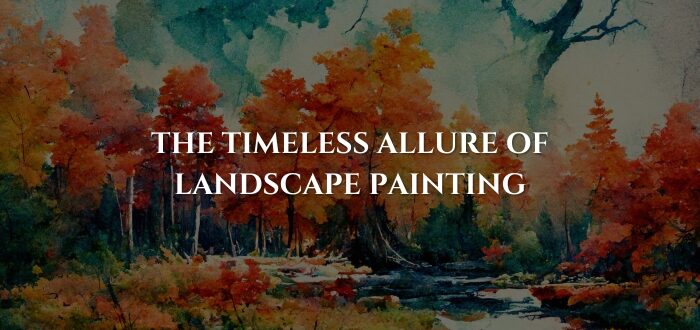The Timeless Allure of Landscape Painting
Landscape painting has been a beloved part of art since ancient times. While relatively new to Western art, landscape painting has been part of the Oriental art for over 1000 years. It was at the end of the Renaissance that landscape painting entered Western art. From sweeping mountain vistas to tranquil riverbanks, landscape paintings or nature paintings connect us deeply with the beauty of the natural world. Artists often turn to nature paintings not just to record a view but to express mood, atmosphere, and personal vision. A scenery painting might portray a glowing sunset, a windswept coastline, or a quiet meadow, each revealing the artist’s unique perspective. The tradition of art landscape painting explores how colours, textures, and light bring scenery in art to life. Whether working in a studio or engaging in painting in nature, creators are united by a shared desire to preserve fleeting moments of natural beauty.

The Timeless Appeal of Landscape Painting
Landscape paintings have captivated art lovers for centuries, offering an escape into serene countryside, towering mountain ranges, and tranquil coastlines. No matter where you’re from, there’s something in a scene of mountains, fields, or forests that resonates. Early civilizations decorated pottery and walls with stylized depictions of rivers and hills. By the end of the Renaissance, landscapes evolved into independent subjects, not merely backgrounds for portraits or historical scenes. Their timeless appeal lies in:
- Universal Connection to Nature
Landscapes tap into a shared human appreciation for the natural world, making them relatable across cultures and eras.

- Emotional Resonance
They evoke powerful feelings such as peace, awe, nostalgia, or wonder, allowing viewers to connect on a personal level.
- Visual Escape and Inspiration
They offer a window into places we long for or dream about, providing beauty, inspiration, and a mental break from daily life.
What Is Landscape Painting?
Landscape painting is the artistic depiction of natural scenery. These works may capture mountains, valleys, rivers, lakes, forests, coastlines, and fields, sometimes including man-made elements such as buildings, roads, or figures. The subject can range from the shimmering surface of a calm sea to the dramatic rise of storm-tossed waves.
As the art form developed through different stages of history, one constant remained: landscape painting reflects nature as the artist sees and feels it. A scene might evoke peace through a quiet meadow or a tranquil harbour with ships, or it might convey raw power through turbulent seas and dark, gathering clouds. Whether serene, vibrant, or tempestuous, landscapes connect with viewers on a universal level, inviting them into the mood, atmosphere, and story within the scene.
Evolution Of Landscape Paintings
Landscape painting has a rich, cross-cultural history that spans centuries, evolving alongside shifting artistic ideals and cultural values.
Credit: Susan Euler
- The Beginnings in Eastern Art
The origins of landscape painting can be traced to 4th-century China, where artists saw nature as a profound source of spiritual and philosophical inspiration. They portrayed snow-covered mountains, flowing rivers and sturdy trees, often to depict their poems and stories to form pictorial narratives. These works were not simply depictions of scenery but meditations on harmony, balance, and the transience of life.
- The Rise in Western Art
In Europe, landscape painting did not emerge as an independent subject until the 16th century. While earlier art often included natural settings as backdrops for religious or historical scenes, painters like Albrecht Altdorfer began to create the first “pure” landscapes—artworks in which nature itself was the central focus.
- The Birth of the Classical Landscape
The 17th century gave rise to the classical landscape, inspired by the ideals of classical antiquity. Artists sought to present nature harmoniously, combining real scenery with imagined elements to evoke balance.
- The Romantic Edge
By the late 18th and early 19th centuries, the Romantic movement transformed landscape painting yet again. Artists began to explore nature’s untamed power, grandeur, and mystery. The concept of the sublime—nature as awe-inspiring and beyond human control—took center stage, resulting in dramatic seascapes, stormy skies, and rugged wilderness scenes that stirred both wonder and fear.
- The Modern Landscape
The 19th century marked a turning point in the history of landscape art. With the Industrial Revolution reshaping life and the land, the artists subject and perspective also changed. Across Europe and North America, landscape painting rose to prominence, no longer viewed as a secondary genre but as a subject worthy of mastery in its own right.
In France, the Barbizon painters—figures like Théodore Rousseau and Charles Daubigny—moved away from the idealized, classical vision of nature. Instead, they embraced plein air painting, working outdoors to capture the immediacy of light, weather, and atmosphere. This period also saw the advent of landscape photography, a new medium that profoundly influenced painters’ compositional choices.
Types of Landscape Paintings
Landscape art takes many forms, each offering a unique way of interpreting the natural world. Here’s a journey through seven of the most prominent styles:

- Realism
Realist landscape painting strives to depict nature with precision and authenticity. Artists in this style aim to capture true-to-life colours, lighting, and forms, often working from direct observation.
- Romanticism
Emerging in the late 18th and early 19th centuries, Romantic landscape painting sought to inspire awe and emotional intensity. Artists used dramatic skies, rugged mountains, and atmospheric light to convey nature’s power and mystery.

- Impressionism
Impressionist landscapes focus on capturing fleeting effects of light and colour rather than fine details. Loose, visible brushstrokes and vibrant palettes create a sense of immediacy, as if the moment is unfolding before the viewer. Claude Monet’s Water Lilies series, depicting his garden pond, is a prime example of this approach—shimmering, soft, and ever-changing with the light.
Also Read: Impressionist Art Moment
- Post-Impressionism
Building on Impressionism’s foundations, Post-Impressionist landscape painters such as Vincent van Gogh and Paul Cézanne introduced bolder colours, stronger brushwork, and more structured compositions.
- Expressionism
Expressionist landscapes prioritize emotion over accuracy, using exaggerated colours, distorted forms, and dynamic brushwork to communicate mood. This style transforms nature into a psychological landscape, reflecting the artist’s inner state as much as the outer world.
- Surrealism
Surrealist landscapes merge the real with the imaginary, blending natural scenery with dreamlike, fantastical elements. Mountains may float in the sky, deserts stretch into infinity, or oceans spill into impossible spaces. Inspired by the subconscious, these works invite viewers into otherworldly realms where the laws of nature are suspended.
Also Read: Exploring the Surrealist Movement
- Contemporary Approaches
Today’s landscape painters push the boundaries of the genre, experimenting with abstraction, mixed media, and digital tools. Some reinterpret traditional vistas with modern palettes and techniques, while others integrate photography, collage, or 3D modelling to create hybrid works that challenge our definition of what a landscape can be.
Power Of Landscape Art
Landscape painting has transformed over the centuries, offering an ever-expanding range of artistic expressions that capture the beauty, power, and complexity of the natural world. From the delicate precision of a traditional scenery painting to the bold innovation of contemporary digital works, the genre continues to inspire and adapt. By engaging in painting in nature, artists sharpen their technical skills while deepening their connection to the environment. In every brushstroke, nature paintings serve as both a celebration and a reminder—inviting us to cherish the landscapes we love and to protect them for generations to come.






